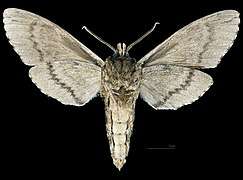Ceratomia hageni
Ceratomia hageni, the Osage orange sphinx or Hagen's sphinx, is a hawk moth (family Sphingidae). The species was first described by Augustus Radcliffe Grote in 1874.
| Hagen's sphinx | |
|---|---|
.jpg) | |
| Scientific classification | |
| Kingdom: | Animalia |
| Phylum: | Arthropoda |
| Class: | Insecta |
| Order: | Lepidoptera |
| Family: | Sphingidae |
| Genus: | Ceratomia |
| Species: | C. hageni |
| Binomial name | |
| Ceratomia hageni | |
Distribution
Ceratomia hageni is a native of midwest North America and can be found from Michigan to Georgia, Nebraska to Texas, and most places in between, with regards to its only known host plant.
Biology
From oviposition of the eggs to pupation, approximately four weeks will pass. Where multiple broods occur, pupae will eclose in two weeks, or when conditions are suitable in cool climates. An adult C. hageni has many colors, viewable when looked over thoroughly. The forewing is grayish-green and has many, wavy lines, similar to other specimens of the Ceratomia genera. The hindwing is a browner gray with a lighter gray towards the outer margins
Description
Egg
The eggs are translucent, milky white and green, oval and about 0.5 mm in diameter. They are laid in masses on the undersurface of leaves, while smaller masses are deposited onto branches on the Osage orange tree. Eggs incubate and hatch five to seven days after oviposition.
Larva
Pupa
As with most other Sphingidae, Ceratomia hageni will burrow into the ground after its fifth and final instar in order to pupate. The larvae will go into a "wandering" stage where it leaves the Osage orange tree and climbs to the ground to find a place to bury itself so that it may pupate. The larvae will then shed its fifth instar skin to reveal its pupal skin, which will be soft and almost translucent at first, but will then harden to a light brown for protection from the elements.
Imago
 Ceratomia hageni ♂
Ceratomia hageni ♂ Ceratomia hageni ♂ △
Ceratomia hageni ♂ △
References
- "CATE Creating a Taxonomic eScience - Sphingidae". Cate-sphingidae.org. Archived from the original on 2012-07-21. Retrieved 2011-11-01.
External links
- Hagen's sphinx Moths of North America Guide
- Ceratomia hageni, Sphingidae of the Americas